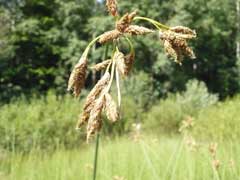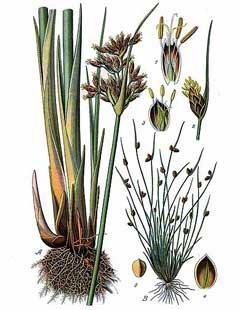 |
|
http://commons.wikimedia.org/wiki/User:OldMuzzle |
 |
| http://commons.wikimedia.org/wiki/File:360_Scirpus_lacustris_L.,_S._setaceus_L.jpg |
Translate this page:
Summary
Physical Characteristics

 Scirpus lacustris is a PERENNIAL growing to 2.5 m (8ft 2in).
Scirpus lacustris is a PERENNIAL growing to 2.5 m (8ft 2in).
See above for USDA hardiness. It is hardy to UK zone 4. It is in flower from June to August, and the seeds ripen from August to September. The species is hermaphrodite (has both male and female organs) and is pollinated by Wind.
Suitable for: light (sandy), medium (loamy) and heavy (clay) soils. Suitable pH: mildly acid, neutral and basic (mildly alkaline) soils. It can grow in semi-shade (light woodland) or no shade. It prefers moist or wet soil and can grow in water.
UK Hardiness Map
US Hardiness Map
Synonyms
Schoenoplectus lacustris. (L.)Pallas.
Plant Habitats
Pond; Bog Garden;
Edible Uses
Edible Parts: Leaves Pollen Root Seed Shoots Stem
Edible Uses:
Root - raw or cooked[2, 85, 95, 183]. Rich in starch, it can be dried and ground into a powder or made into a syrup[13, 85, 95, 183]. The buds at the end of the rhizomes are crisp and sweet, making excellent eating raw[183]. Young shoots - raw or cooked[85, 183]. Used in spring. Seed - ground up into a powder and mixed with flour for use in making cakes etc[85, 183]. The seed is small and rather fiddly to harvest and utilize. Base of mature stems - raw or cooked. Somewhat tough[85]. Pollen - raw or cooked. Rich in pollen, it is mixed with flour and used in making cakes etc[85, 183].
References More on Edible Uses
Medicinal Uses
Plants For A Future can not take any responsibility for any adverse effects from the use of plants. Always seek advice from a professional before using a plant medicinally.
Astringent Cancer Diuretic
The roots are astringent and diuretic[240]. They were formerly employed medicinally but have fallen into disuse[4]. This plant is a traditional medicine for cancer[218].
References More on Medicinal Uses
The Bookshop: Edible Plant Books
Our Latest books on Perennial Plants For Food Forests and Permaculture Gardens in paperback or digital formats.

Edible Tropical Plants
Food Forest Plants for Hotter Conditions: 250+ Plants For Tropical Food Forests & Permaculture Gardens.
More

Edible Temperate Plants
Plants for Your Food Forest: 500 Plants for Temperate Food Forests & Permaculture Gardens.
More

More Books
PFAF have eight books available in paperback and digital formats. Browse the shop for more information.
Shop Now
Other Uses
Paper Thatching Weaving
The stems are frequently used for making matting, chair bottoms etc and thatching[1, 4, 23, 85, 100, 115]. They were at one time imported in large quantities for this purpose[4]. The pith of the stems is used in paper making[100].
Special Uses
References More on Other Uses
Cultivation details
Succeeds in any wet to moisture retentive soil, pond margins and shallow water in full sun or shade[1, 200]. Plants can succeed in fairly deep water. Hardy to about -25°c[187]. Some named forms have been selected for their ornamental value[187].
References Carbon Farming Information and Carbon Sequestration Information
Temperature Converter
Type a value in the Celsius field to convert the value to Fahrenheit:
Fahrenheit:
The PFAF Bookshop
Plants For A Future have a number of books available in paperback and digital form. Book titles include Edible Plants, Edible Perennials, Edible Trees,Edible Shrubs, Woodland Gardening, and Temperate Food Forest Plants. Our new book is Food Forest Plants For Hotter Conditions (Tropical and Sub-Tropical).
Shop Now
Plant Propagation
Seed - sow in a cold frame as soon as it is ripe in a pot standing in 3cm of water. Only just cover the seed with soil[200]. The seed usually germinates fairly quickly. Prick out the plants when large enough to handle and plant out in their permanent positions in early summer. Division in spring. Very easy, larger divisions can be planted out direct into their permanent positions. We have found it best to pot up the smaller divisions and grow them on in a lightly shaded position in a cold frame, planting them out once they are well established in the summer.
Other Names
If available other names are mentioned here
Native Range
TEMPERATE ASIA: Yemen, Afghanistan, Cyprus, Iran (north), Lebanon, Turkey, Russian Federation-Ciscaucasia (Ciscaucasia), Armenia, Azerbaijan, Georgia, Russian Federation (Dagestan), Russian Federation-Eastern Siberia (Eastern Siberia), Russian Federation (Altay, Gorno-Altay, Kemerovskaja oblast, Krasnoyarsk (south), Kurganskaja oblast, Novosibirsk, Omsk, Tomsk, Tyumen, Yakutia-Sakha), Kazakhstan, Kyrgyzstan, Tajikistan, Turkmenistan, Uzbekistan, Mongolia TROPICAL ASIA: India (Jammu and Kashmir) EUROPE: Denmark, Finland, United Kingdom, Ireland, Norway, Sweden, Austria, Belgium, Switzerland, Czech Republic, Germany, Hungary, Netherlands, Poland, Slovakia, Russian Federation (European part), Belarus, Estonia, Lithuania, Latvia, Moldova, Russian Federation (Kalmykija, Respublika, Astrakhan, Saratov, Volgogradskaja oblast), Ukraine (incl. Krym), Albania, Bulgaria, Bosnia and Herzegovina, Greece (incl. Crete), Croatia, Italy (incl. Sardinia, Sicily), Montenegro, Romania, Serbia, Slovenia, Spain (incl. Baleares), France (incl. Corsica), Portugal AFRICA: Algeria, Libya, Morocco, Tunisia, Eritrea, Lesotho
Weed Potential
Right plant wrong place. We are currently updating this section.
Please note that a plant may be invasive in one area but may not in your area so it's worth checking.
Conservation Status
IUCN Red List of Threatened Plants Status :

Growth: S = slow M = medium F = fast. Soil: L = light (sandy) M = medium H = heavy (clay). pH: A = acid N = neutral B = basic (alkaline). Shade: F = full shade S = semi-shade N = no shade. Moisture: D = dry M = Moist We = wet Wa = water.
Now available:
Food Forest Plants for Mediterranean Conditions
350+ Perennial Plants For Mediterranean and Drier Food Forests and Permaculture Gardens.
[Paperback and eBook]
This is the third in Plants For A Future's series of plant guides for food forests tailored to
specific climate zones. Following volumes on temperate and tropical ecosystems, this book focuses
on species suited to Mediterranean conditions—regions with hot, dry summers and cool, wet winters,
often facing the added challenge of climate change.
Read More
Expert comment
Author
L.
Botanical References
17200
Links / References
For a list of references used on this page please go here
Readers comment